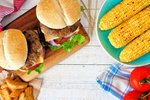

Cookout season is officially here, and so is the increased chance for food poisoning. Though the staple of any summer celebration, the cookout can also be the root of food-related illnesses that becomes ever-prevalent during the summer months. Bacteria such as e.coli thrive in the summer heat, which makes proper food prep ever more important. When it comes to outdoor cooking, the Food and Drug Administration has four steps for safe for handling while at your next meal: clean, separate, cook and chill.
Cleaning exposed surfaces during a cookout is a great preventative measure. Any surface exposed to food prep has a potential for food-borne bacteria. By cleaning hands, utensils, counters and dishes with warm soapy water, there is a reduced chance for these bacteria to survive and effect the food being prepared. It is also recommended to use paper towels rather than clothes to make cleaning while preparing food, due to the convenience and ease of cleaning. If using kitchen clothes, the FDA recommends laundering them regularly in a hot cycle.
Separation: Another important part of prevention is separation. Separating raw meat from other food is crucial to limit the cross contamination of pathogens or germs. This separation extends from using different shopping bags for meat and produce, to using fresh cutting boards and plates for raw vs. cooked food.
Cooking: While at the grill, it is important to check if the food being prepared is thoroughly cooked. A common misconception is based around the belief that color and texture is a good indicator of how well the food is cooked. The FDA assures that “Using a food thermometer is the only way to ensure the safety of meat, poultry, seafood and egg products for all cooking methods. These foods must be cooked to a safe minimum internal temperature to destroy any harmful bacteria.” It is also easy and convent to use a microwave to reheat pre-prepared food. The main concern with this is ensuring that foods are cooked evenly. To do this, cover, stir, and ensure food is rotating within the microwave.
Chill: The FDA suggests that both hot food and cold food should sit out no longer than two hours, or one hour if the temperature is above 90 degrees Fahrenheit. Keeping cold food on ice or in a cooler at around 40 degrees, and hot food in an insulated container at above 140 degrees ensures the prepared food stays out of the “danger zone.” The danger zone is the range of temperatures (between 40-140 degrees) that bacteria thrive in.
To ensure food safety, the FDA also states that food should never be thawed at room temperature; “There are three safe ways to defrost food: in the refrigerator, in cold water, and in the microwave. Food thawed in cold water or in the microwave should be cooked immediately.” Harmful bacteria cannot be tasted, smelled or seen, so when in doubt, throw it out.
If you have any more questions about summer food safety, visit the FDA’s website at https://www.fda.gov/food/buy-store-serve-safe-food/handling-food-safely-while-eating-outdoors, or call the local health department at 765-364-6440.
William Borland, Wabash College ‘22, is an intern with the Montgomery County Health Department.